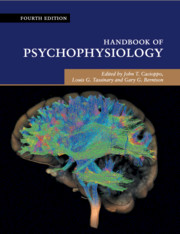37 results
3 - Neuroscience in Psychology
-
-
- Book:
- The Cambridge Handbook of the Intellectual History of Psychology
- Published online:
- 18 May 2019
- Print publication:
- 16 May 2019, pp 63-87
-
- Chapter
- Export citation

Handbook of Psychophysiology
-
- Published online:
- 27 January 2017
- Print publication:
- 15 December 2016
Plate section (PDF only)
-
- Book:
- Handbook of Psychophysiology
- Published online:
- 27 January 2017
- Print publication:
- 15 December 2016, pp -
-
- Chapter
- Export citation
Tables
-
- Book:
- Handbook of Psychophysiology
- Published online:
- 27 January 2017
- Print publication:
- 15 December 2016, pp xiv-xiv
-
- Chapter
- Export citation
General Methods
-
- Book:
- Handbook of Psychophysiology
- Published online:
- 27 January 2017
- Print publication:
- 15 December 2016, pp 581-697
-
- Chapter
- Export citation
Copyright page
-
- Book:
- Handbook of Psychophysiology
- Published online:
- 27 January 2017
- Print publication:
- 15 December 2016, pp iv-iv
-
- Chapter
- Export citation
Contents
-
- Book:
- Handbook of Psychophysiology
- Published online:
- 27 January 2017
- Print publication:
- 15 December 2016, pp v-vii
-
- Chapter
- Export citation
18 - From Homeostasis to Allodynamic Regulation
- from Topical Psychophysiology
-
-
- Book:
- Handbook of Psychophysiology
- Published online:
- 27 January 2017
- Print publication:
- 15 December 2016, pp 401-426
-
- Chapter
- Export citation
Index
-
- Book:
- Handbook of Psychophysiology
- Published online:
- 27 January 2017
- Print publication:
- 15 December 2016, pp 698-715
-
- Chapter
- Export citation
9 - Cardiovascular Psychophysiology
- from Systemic Psychophysiology
-
-
- Book:
- Handbook of Psychophysiology
- Published online:
- 27 January 2017
- Print publication:
- 15 December 2016, pp 183-216
-
- Chapter
- Export citation
Plates
-
- Book:
- Handbook of Psychophysiology
- Published online:
- 27 January 2017
- Print publication:
- 15 December 2016, pp xii-xiii
-
- Chapter
- Export citation
Figures
-
- Book:
- Handbook of Psychophysiology
- Published online:
- 27 January 2017
- Print publication:
- 15 December 2016, pp viii-xi
-
- Chapter
- Export citation
Contributors
-
- Book:
- Handbook of Psychophysiology
- Published online:
- 27 January 2017
- Print publication:
- 15 December 2016, pp xv-xvi
-
- Chapter
- Export citation
Topical Psychophysiology
-
- Book:
- Handbook of Psychophysiology
- Published online:
- 27 January 2017
- Print publication:
- 15 December 2016, pp 399-580
-
- Chapter
- Export citation
Systemic Psychophysiology
-
- Book:
- Handbook of Psychophysiology
- Published online:
- 27 January 2017
- Print publication:
- 15 December 2016, pp 39-398
-
- Chapter
- Export citation
1 - Strong Inference in Psychophysiological Science
- from Foundations
-
-
- Book:
- Handbook of Psychophysiology
- Published online:
- 27 January 2017
- Print publication:
- 15 December 2016, pp 3-15
-
- Chapter
- Export citation
Foundations
-
- Book:
- Handbook of Psychophysiology
- Published online:
- 27 January 2017
- Print publication:
- 15 December 2016, pp 1-38
-
- Chapter
- Export citation
Cerebellar contributions to response selection
-
- Journal:
- Behavioral and Brain Sciences / Volume 2 / Issue 2 / June 1979
- Published online by Cambridge University Press:
- 19 May 2011, pp. 214-215
-
- Article
- Export citation
1 - Psychophysiological Science
-
-
- Book:
- Handbook of Psychophysiology
- Published online:
- 05 June 2012
- Print publication:
- 05 March 2007, pp 1-16
-
- Chapter
- Export citation
8 - Cardiovascular Psychophysiology
- from FOUNDATIONS OF PSYCHOPHYSIOLOGY
-
-
- Book:
- Handbook of Psychophysiology
- Published online:
- 05 June 2012
- Print publication:
- 05 March 2007, pp 182-210
-
- Chapter
- Export citation



